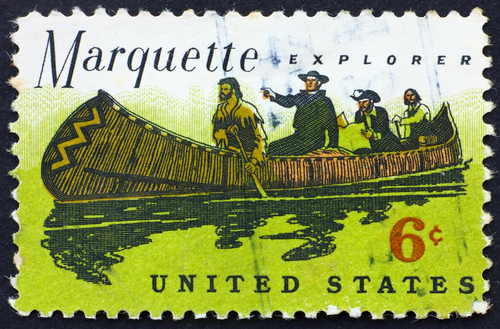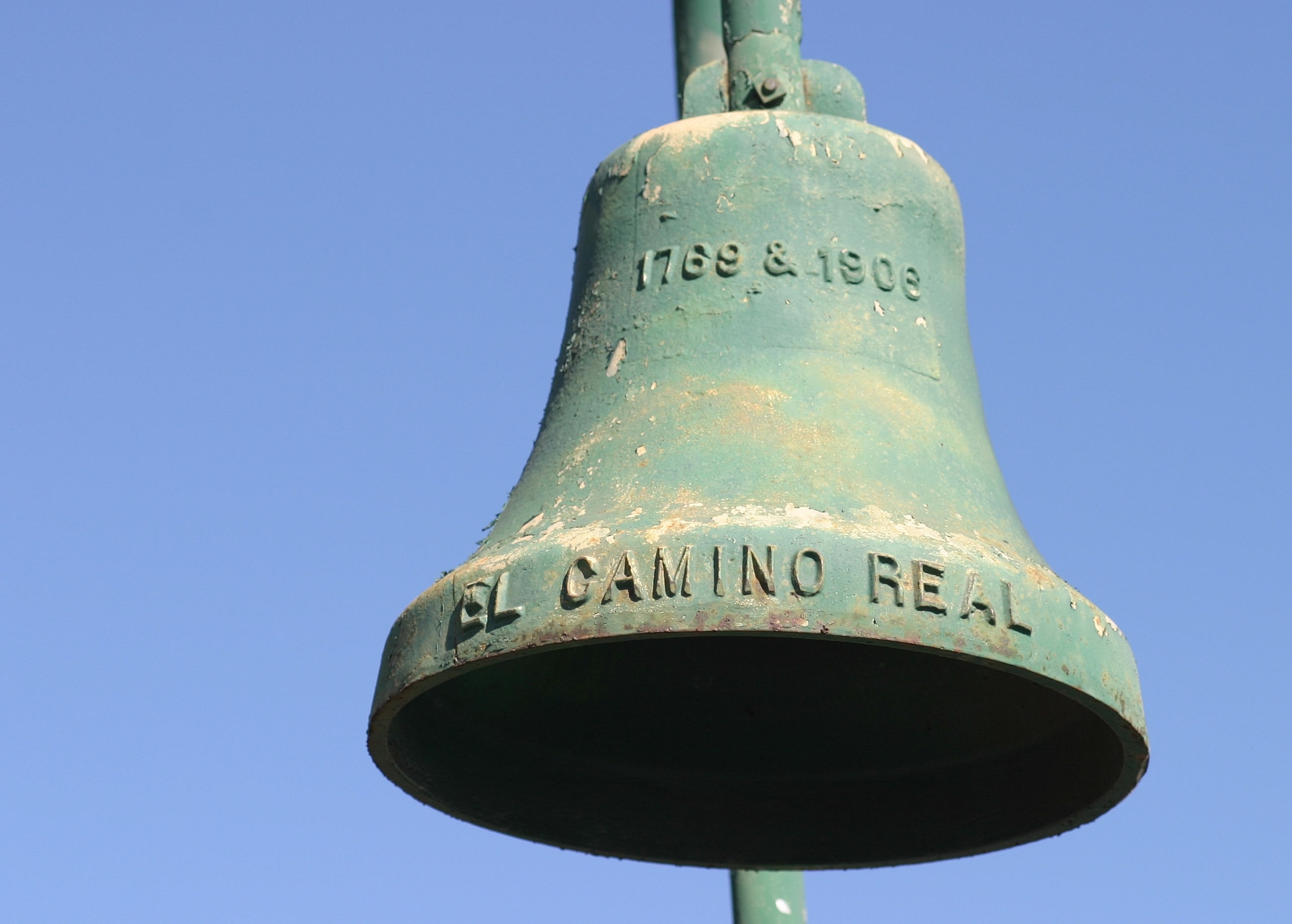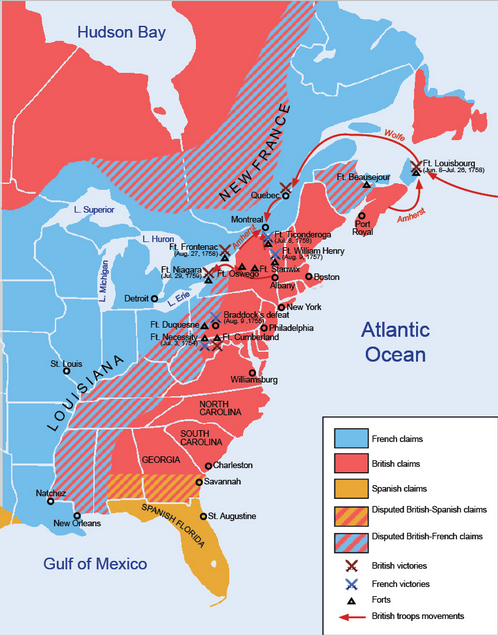New French Colonies
The French held vast territories in what today is the midwest of the United States. They were mostly traders and fur trappers, but they did not have established colonies like the English. Land was less of an issue in France than England, so French peasants had less economic incentive to leave. The French Crown was far more interested in its holdings in Asia and the sugar islands of the Caribbean, so the French monarchs did little to sponsor emigration to North America.
Further, the French also did not have the freedom to govern themselves as the French government was an absolute monarchy and liked to have complete control over those in the Americas.

A stamp printed in the U.S. around 1968 shows Father Jacques Marquette and Louis Jolliet, explorers of the Mississippi River.
The British were not the only Europeans who were colonizing North America, however. Elsewhere on the continent, the Spanish and the French had built settlements of their own. The French had founded Quebec in 1608. At first, they had little interest in large-scale settlement in North America. They were mainly concerned with fishing and trapping animals for their fur. French trappers and missionaries went far into the interior of North America. French fur companies built forts and trading posts to protect their profitable trade. In 1663, New France became a royal colony. King Louis XIV limited the privileges of the fur companies. He appointed a royal governor who strongly supported new exploration.
In the 1670s, two Frenchmen, a fur trader named Louis Joliet, and a priest named Jacques Marquette, explored the Mississippi River by canoe. Joliet and Marquette hoped to find gold, silver, or other precious metals. They were also looking for a water passage to the Pacific Ocean. The two explorers reached as far south as the junction of the Arkansas and Mississippi Rivers. When they realized that the Mississippi flowed south into the Gulf of Mexico rather than west into the Pacific, they turned around and headed back upriver.
A few years later, René-Robert Cavelier, Sieur de La Salle, followed the Mississippi River all the way to the Gulf of Mexico. La Salle claimed the region around the river for France. He called this territory Louisiana in honor of King Louis XIV. In 1718, the French governor founded the port of New Orleans near the mouth of the Mississippi River. Later French explorers, traders, and missionaries traveled west to the Rocky Mountains and southwest to the Rio Grande. French settlement in North America advanced very slowly. Settlement in New France consisted of a system of estates along the St. Lawrence River. The estate holders received land in exchange for bringing settlers to the colony. Known as tenant farmers, the settlers paid their lord an annual rent and worked for him for a fixed number of days each year.
The French had better relations with the Native Americans than did other Europeans. French trappers and missionaries traveled deep into Native American lands. They lived among the Native American peoples, learned their languages, and respected their ways. Although the missionaries had come to convert Native Americans to Catholicism, they did not try to change the Native Americans’ customs. Most importantly, the French colony grew so slowly that Native Americans were not pushed off their lands.

A bell marking the historic El Camino Real in California
In the early 1600s, England, France, and the Netherlands began their colonization of North America. The Spanish, however, still controlled most of Mexico, the Caribbean, and Central and South America. They also expanded into the western and southern parts of what would one day be the United States. Spain was determined to keep the other European powers from threatening its empire in America. To protect their claims, the Spanish sent soldiers, missionaries, and settlers north into present-day New Mexico.
In late 1609 or early 1610, Spanish missionaries, soldiers, and settlers founded Santa Fe. Another group of missionaries and settlers went to what is now Arizona in the late 1600s. When France began exploring and laying claim to lands around the Mississippi River, the Spanish moved into what is now Texas. Spain wanted to control the area between the French territory and their own colony in Mexico. In the early 1700s, Spain established San Antonio and seven other military posts in Texas.
Spanish priests built a string of missions along the Pacific coast. Missions are religious settlements established to convert people to a particular faith. The missions enabled the Spanish to lay claim to California. The Spanish did more than convert Native Americans to Christianity. Spanish missionaries and soldiers also brought them to the missions, often by force, to serve as laborers in fields and workshops.
In 1769, Junípero Serra, a Franciscan monk, founded a mission at San Diego. Over the next 15 years, Father Serra set up eight more missions in California along a route called El Camino Real, or “The Royal Highway”. Some of his missions would grow into such cities as Los Angeles and Monterey. The distance from one mission to the next was usually a day’s walk, and Serra traveled on foot to visit each one and advise the missionaries. Serra also championed the rights of the Native Americans. He worked to prevent Spanish army commanders in the region from mistreating them.
Analyze the Map
What advantage did the British colonies have over the French?
Analyze the Map
Why do you think certain areas were under dispute?
Analyze the Map
What country controlled the cities of Montreal and Quebec in Canada?
| Your Responses | Sample Answers |
|---|---|
| The land that the British colonies had was on the coast, which is more beneficial to trade. | |
| Boundaries were not quite settled yet, so there was a bit of a power struggle. | |
| France | |

